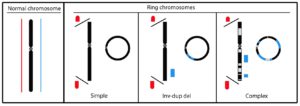Ring chromosomes with a highly complex structure derived by chromoanasynthesis events have been so far reported in only in cancer. We show that a germline ring chromosome 22, detected in a child with a severe neurodevelopmental disorder, was in fact the product of a de novo catastrophic event producing the deletion of the distal 22q13 region containing SHANK3 and the inversion and displaced order of eight fragments, three of them duplicated. The child’s clinical features, that a posteriori could be framed within the Phelan-McDermid syndrome with additional cortical brain abnormalities and recurrent urticarial skin rashes, appear to be due to the global alteration of the topological chromatin organization rather than simply to the deletion or duplication of dosage-sensitive genes. (By Dr. Maria Clara Bonaglia, http://jmg.bmj.com/content/early/2018/01/28/jmedgenet-2017-105125 )
Different pathways leading to disease-causing germline ring chromosomes. In all cases the circular conformation was accompanied by the loss of both ends of the chromosome. Black, red and blue correspond respectively to: normal, deleted, and duplicated portions; in grey are normal copy regions in random order.
